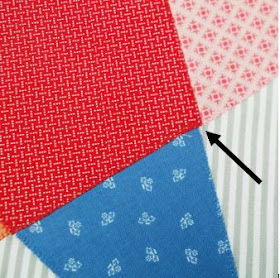I love
stars in the sky and stars in the workroom.
So I am thrilled to be sewing along with Lori Holt in her Farmhouse Star sew-along. Whilst
Lori has her own unique method of applique I much prefer quick fuse applique (a.k.a. raw edge), which I will be using for the large star in the center of the quilt and all the stars that sit in circles. So I thought I might share
with you some tips and pointers as I sew along.
The first star of the sew along is a huge 16” star which sits in the middle of the quilt. It is created using pieces G-16c and G-16p from Lori's Star Sew Simple shapes. But first we need to cut our background square.In her You Tube video, Lori cut the background square larger than required as she intended to trim it once the star had been stitched in place. However, this is not needed with quick fuse applique so, straight away we can save a little bit of work by cutting the background square to the exact size needed - 18½” square.
 |
Choose your background fabric carefully.
If the print is not straight it will show! |
With quick fuse applique you can then trace around the templates just as they are. However, if you add a ¼” section to the bottom of each point tracing as shown below, you will reduce the amount of sewing needed and keep the applique neat.
 |
| A little ¼” addition will reduce the amount of sewing needed |
This extra ¼” allowance will sit under the center pentagon, eliminating the need to sew the bottom edge of each point as this will be secured at the same time as you stitch the pentagon into positon.
Tip: Once
your background fabric is cut and you have traced, fused and cut your shapes out, remove the paper from the back of your points but DO NOT remove the
paper from the back of the pentagon at this time.
Position the pentagon centrally onto the background square and begin to place the points, one by one, around the pentagon, slipping the extra
¼” allowance under the edges of the pentagon. (The paper backing on the pentagon should make it easier to slide the points under the pentagon.)
 |
| Slide the bottom edge of the points under the pentagon. |
You
will have to fiddle a little, here and there, but eventually all five points
should sit neatly under the pentagon with the corners of the pentagon meeting roughly at the intersection of two points.
 |
| The pentagon should sit atop the star points |
But do
not worry if they are slightly out – it won’t be noticeable on the finished
quilt and, as Lori says "it is not about perfection".
 |
| My points are slightly out here but it won't affect the finished quilt |
Make sure the tips of the two side star points (coloured aqua and pink in my star) are at least 1” in from the side edges of the backgound square. The top point (the yellow point in my star) should be approximately 1½”-1¾” down from the top edge.
When you are happy with the layout carefully lift and remove the backing paper from the pentagon before placing it back into position. Now you can fuse the star into place. Stitch the pentagon first so
that the bottom of each point is secured. Once this is done, you can stitch around each point.
And
there you have it …. the first star in the Farmhouse Star
sew-along. All that is left to do is to add the border
rectangles and squares as per the pattern and congratulate yourself on making a huge start to a spectacular quilt.
Next
time I shall quick fuse applique stars onto circles and circles onto the squares so be sure to check back with me really soon. Until then
…..
































